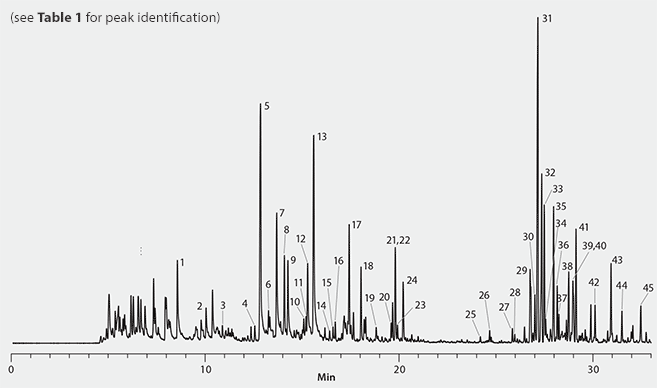Cannabis Terpene Analysis by Headspace SPME GC/MS
Katherine K. Stenerson, Principal Scientist
Reporter US Volume 34.4
A Rapid Method to Identify Cannabis Terpenes for Forensic and Organoleptic Applications
Cannabis sativa (cannabis or marijuana) contains over 100 different terpenes and terpenoids, including mono, sesqui, di and tri, as well as other miscellaneous compounds of terpenoid orgin.1 Terpenes give the plant distinct organoleptic properties and produce characteristic aromas when the buds are heated or vaporized.2 Although the terpene profile does not necessarily indicate geographic origin of a cannabis sample, it can be used in forensic applications to determine the common source of different samples.3 In addition, different cannabis strains have been developed which have distinct aromas and flavors, a result of the differing amounts of specific terpenes present.4
Experimental
Dried cannabis sample was obtained courtesy of Dr. Hari H. Singh, Program Director at the Chemistry and Physiological Systems Research Branch of the United States National Institute on Drug Abuse at the National Institute of Health. Terpenes were isolated using headspace solid phase microextraction (SPME) followed by chromatographic separation on an Equity®-1 capillary GC column. Peak identifications were assigned using MS spectral matching against reference spectra in the Wiley and NIST libraries. Confirmatory identification was done based on retention index, which was calculated for the compounds identified in each sample using an n-alkane standard analyzed under the same GC conditions. This data was compared with published values and peak identifications were assigned.6,7 Final analytical conditions appear in Figure 1.

Figure 1. Headspace SPME-GC/MS Analysis of Dried Cannabis Sativa.
Results and Discussion
The terpenes identified in the cannabis sample (Figure 1) are indicated in Table 1. The profile was similar to those found previously in the analysis of dried cannabis.3,5 Early eluting peaks generally were monoterpenes and monoterpenoids. The later eluting peaks consisted of sequiterpenes and caryophyllene oxide, which is a sequiterpenoid. The most abundant terpene was caryophyllene. The predominance of this compound could be due to the specific strain of cannabis tested, and/or the nature of the sample tested, which was dried. Previous studies have shown the level of this compound to increase significantly relative to other terepenes and terpenoids with drying.3 Consequently, the levels of the more volatile monoterpenes and terpenoids would be expected to be less, and this was observed to some degree. Among the monoterpenes and terpenoids, the most abundant were α-pinene and limonene.
References
To continue reading please sign in or create an account.
Don't Have An Account?